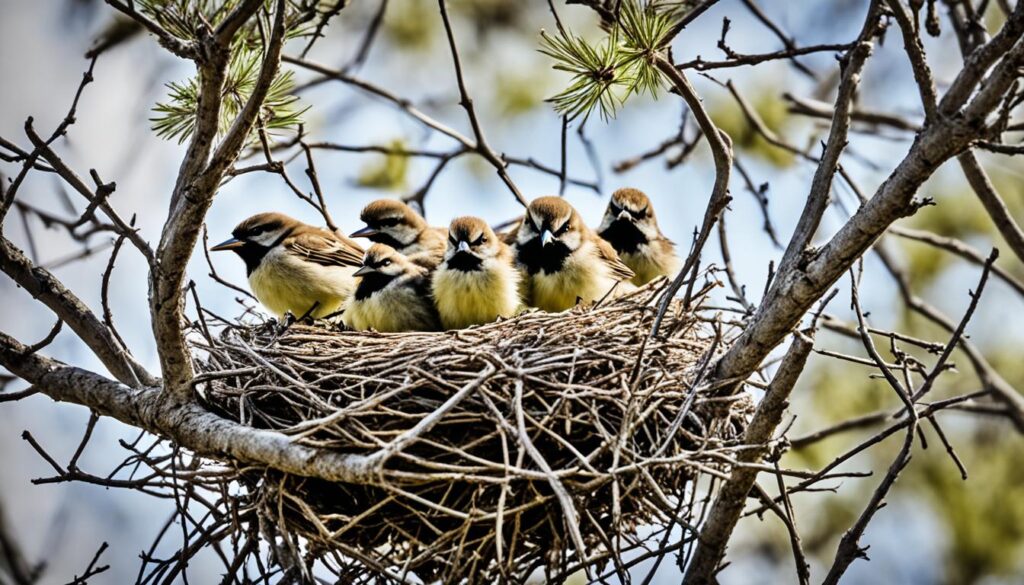Imagine finding a nest with 7 chicks, abandoned by their parents a week before they could fly. This terrible event from 2016 shows how fragile the life of a baby bird is. These tiny creatures, needing special care, highlight the importance of knowing about their feeding needs. It’s crucial for anyone who comes across baby birds to understand how long they can survive without food.
Key Takeaways
- Baby birds have high metabolic rates and deteriorate quickly without adequate food, making prompt intervention crucial.
- Nestling survival depends on their age, with older chicks having a better chance of surviving food deprivation.
- Fledglings, while more independent, still require frequent feedings from their parents to avoid starvation.
- Proper feeding techniques and a suitable environment are essential for caring for orphaned or distressed baby birds.
- Contacting a licensed wildlife rehabilitator is recommended for the best chance of survival for rescued baby birds.
Introduction to Baby Bird Hunger
Baby birds, whether nestlings or fledglings, need special care for their growth. Nestlings are very young, living in the nest. They rely completely on their parents for food. They can face a real risk of starving if they don’t get enough to eat. It’s key to know how to feed nestlings and prevent this risk.
Understanding the Feeding Needs of Nestlings
The feeding schedule is key to a nestling’s life. Within 12 hours, you should feed them every 15 minutes when their eyes are still shut. If they can see, feed them every 30 minutes. When they can stand, it’s every 45 minutes. Once they’re out of the nest, it’s every 2 hours.
The food’s temperature matters too. It should be about 100 degrees Fahrenheit. This ensures the food is safe for them to eat.
Factors Affecting Baby Bird Starvation Risk
Every bird species has its own nutritional needs. Giving them the wrong food can be deadly. It’s a slow but worthy effort to teach baby birds to eat. They won’t eat if they’re cold, or if their food is cold.
If you’re hand-feeding, be very careful not to drown the bird. The syringe method can be tricky. By the end of a week, they should be eating on their own. Keep them warm and quiet after a fall. Watch for any signs of trouble or injury closely.
Some birds, like raptors, can harm you. They should only be handled by experts. Nestling survival without food is a fine line. Knowing what they need is key to keeping them safe and healthy.
Baby Bird Feeding Frequency
Newborn baby birds eat a lot and need to be fed every 15-30 minutes during the day. This helps them grow quickly and meets their high-energy needs. As they get older, the time between feedings can get longer. But, sticking to a regular feeding schedule is still important for their growth and well-being.
A baby bird has a special pouch in its throat called a crop. This crop shouldn’t be allowed to go completely empty. It needs to be refilled often since it can only hold food for about 4 hours. Keeping their crop full is vital for a young bird’s growth and survival.
- Baby birds can be fed every 2-3 hours around the clock during the period from hatching to one week old.
- Birds between two to three weeks of age can be fed every three to four hours from 6:00 A.M. to midnight.
- Three to four-week-old birds should be fed every 4 hours.
- Five to six-week-old birds should be fed twice daily.
- Birds should not be weaned before 7 weeks, usually around 8 weeks, and should be closely monitored during the weaning process.
Following the right feeding times is crucial for baby birds to grow well. It’s important not to overfeed, especially as they start to wean. Weaning birds can naturally lose up to 10% of their weight. So, it’s a good idea to weigh them often during this time.
| Baby Bird Age | Feeding Frequency |
|---|---|
| Hatching to 1 week | Every 2-3 hours around the clock |
| 2 to 3 weeks | Every 3-4 hours from 6 AM to 12 AM |
| 3 to 4 weeks | Every 4 hours |
| 5 to 6 weeks | Twice daily |
| 7 to 8 weeks | Weaning period, close monitoring required |
By following these feeding tips, caregivers can ensure baby birds do well. Good feeding habits help them become able to eat on their own successfully.
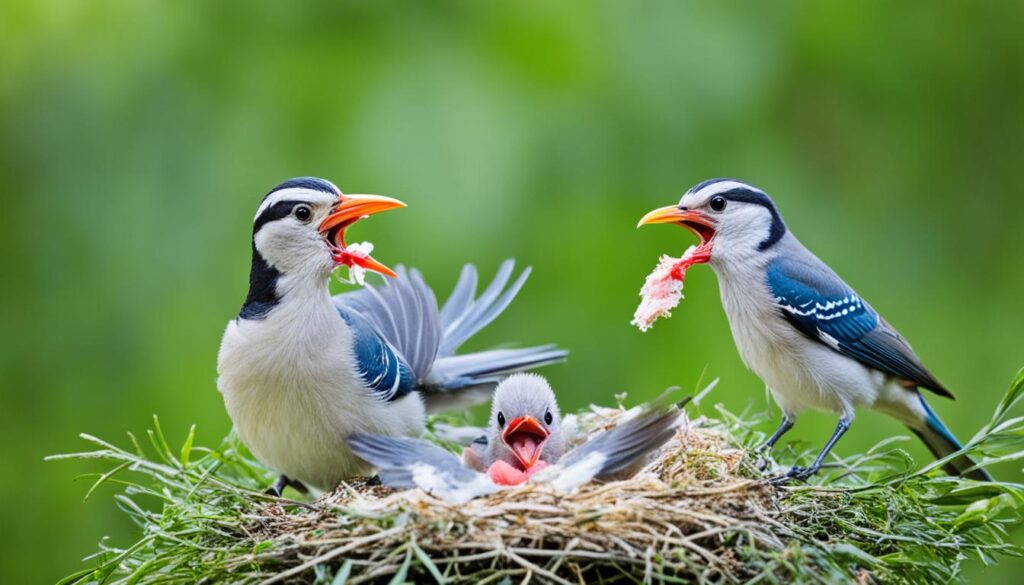
How Long Can Baby Birds Go Without Food?
A baby bird’s ability to go without food depends on its age and the type of bird. It’s important to know the needs of different baby bird stages. This helps keep them healthy and alive.
Nestling Survival Without Food
Nestlings are very young birds that need their parents for everything. They have pink, bare skin and most often, closed eyes. Nestlings need a lot of care. They can only last a few hours without food, then they might starve.
Experts say baby birds can go a while without food. Yet, animal hospitals feed the youngest every 45 minutes. This fast feeding pace matches their growing bodies’ high needs.
Fledgling Food Deprivation Limits
Fledglings are older birds with some feathers. They can’t fly yet but have left the nest. They might last longer without food than nestlings. Still, they need to be fed often to survive.
For example, songbird fledglings get fed several times an hour. Their parents feed them for weeks after they leave the nest. If fledglings can’t find their parents, they can starve. It’s vital to keep them where their parents can find them.
If you find a baby bird and the parents aren’t around, act fast. Nestlings can go an hour without food before it’s really bad. Following advice not to feed them before rehab can be best. A hummingbird got better and flew free thanks to this.
Risks of Improper Feeding
Feeding a baby bird without the right know-how is risky. If you try to help without the right skills, you might give them the wrong food. Or you could hurt them while trying to feed, which might cause injury or death.
Common Feeding Mistakes to Avoid
There are key mistakes to dodge when feeding baby birds. It’s best not to:
- Overfeed, as it can harm them
- Choose wrong foods, which won’t help their health
- Try to push food in, as it’s not good for them
Finding the right feeding schedule is also vital. Research shows that newborn chicks need to eat often. They should be fed 6-10 times a day, about every 2-3 hours. If they can’t see yet, feed them 5-6 times daily, every 3-4 hours. For chicks with open eyes, feed them 3-5 times a day, spacing it out to every 5 hours. Younger chicks might even need up to 6 feedings each day.
It’s important to check if the bird is gaining weight. Birds that are not gaining might be sick, and they need a vet check right away. You must also keep the feeding area clean to prevent infections.
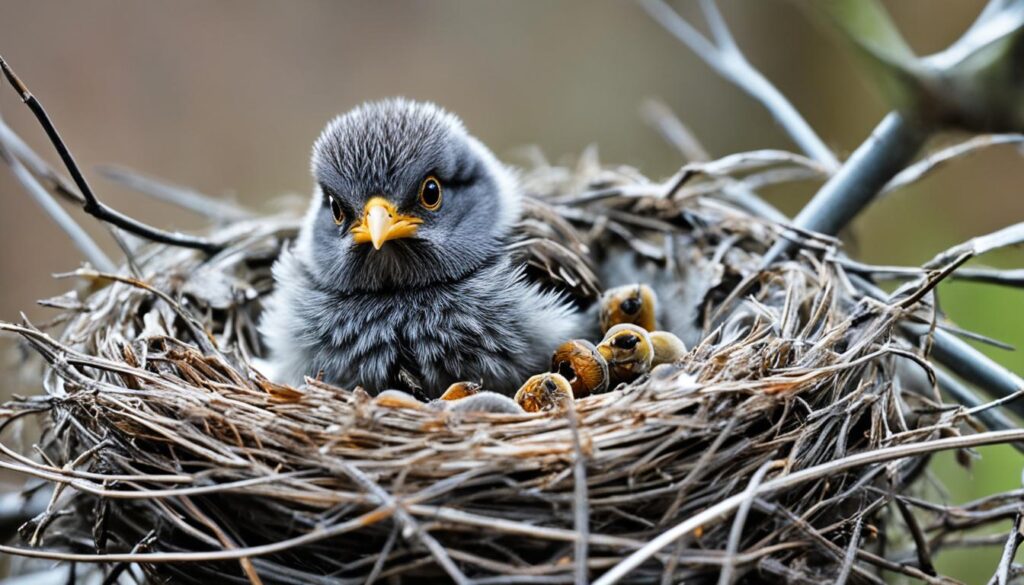
Watch for signs that a baby bird is not doing well. Signs like constant chirping, not wanting to eat, or odd body positions are bad signals. If you notice these, getting expert help fast is critical for the bird’s health.
“Overfeeding, providing the wrong food, or attempting to force-feed a baby bird can have devastating consequences. It’s crucial to avoid these common mistakes and seek professional guidance to ensure the bird’s proper care and nutrition.”
Identifying Nestlings and Fledglings
It’s key to know the difference between nestlings and fledglings to help them. Nestlings are newborns with no feathers. They need their parents for everything. Fledglings have some feathers, and they’re beginning to leave the nest. But, they’re still cared for by their parents.
Hatchlings just hatched, have no feathers, and eyes are shut. Nestlings are about 3 days to two weeks old and have started feathering. Fledglings, two weeks or more, have open eyes and feathers showing.
Knowing nestlings from fledglings is crucial. Most birds found on the ground, about 80%, are nestlings that fell from nests. Placing a nestling back in its nest means 75% of the time, parents will be back within an hour.
However, 20% are fledglings, ready to be on the ground. They are usually fine and well-fed by parents. They have a high success rate of 90%.
Watch a bird closely if you think it’s sick or hurt and might need help from a center. Signs include messy feathers, injuries, or strange eyes. Look for signs like these to spot a bird in need.
“Sick or injured birds are rare, making up only 3% of cases. They might show signs like a bad posture or breathing.”
Remember, keeping wild birds is against the law because of the Migratory Bird Treaty Act of 1918. Always hand them over to experts for care.
When to Intervene
It’s usually best to leave baby birds alone and let nature run its course. But sometimes, we need to help. It’s important to watch for signs of distress or injury first. This way, we can make sure our help is right and doesn’t hurt the bird.
Signs of Distress or Injury
Look out for these signs to know if a baby bird needs help:
- Lethargy or unusual vocalization – A baby bird that looks very tired, weak, or sounds odd may be sick or hurt.
- Visible wounds or bleeding – Birds with cuts or bleeding need immediate medical help, especially if from an accident or attack.
- Presence of potential predators – If a baby bird is in danger from other animals, like cats, it’s time to step in for its safety.
Remember, touching a baby bird doesn’t make their parent leave them. This myth is because birds can’t smell well. Still, it’s better to not handle them too much. It could stress or hurt them.
If you find a baby bird in trouble, the first thing to do is call a local wildlife center. They’ll give you the best advice. These specialists can figure out what the bird needs and how to help.
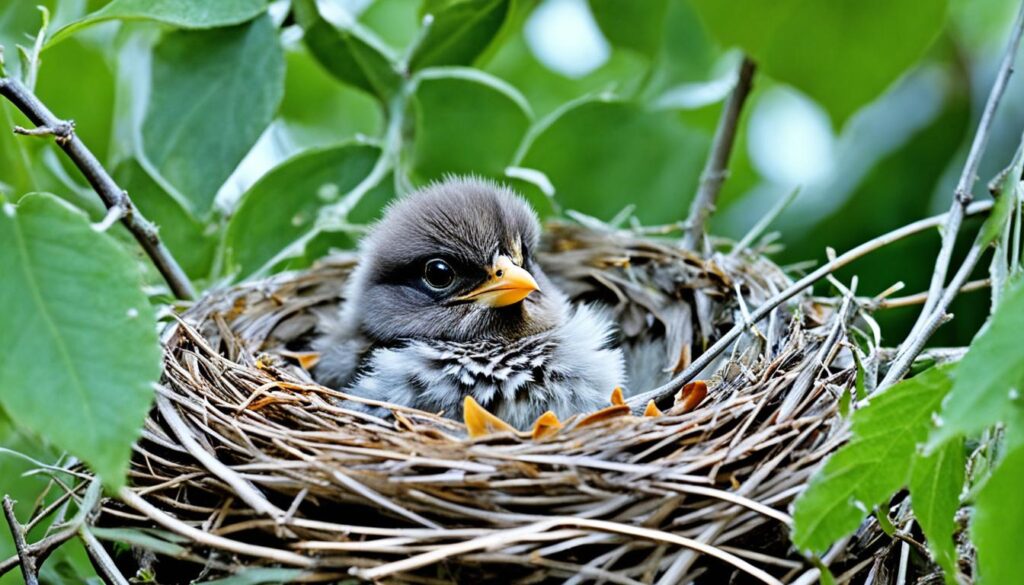
“Intervening at the right time can make all the difference for a baby bird in need, but it’s important to do so with caution and in consultation with wildlife professionals.”
Orphaned Baby Bird Care
When a baby bird’s parents are gone, it needs special care. This might mean taking it to a place that helps wildlife, like a wildlife rehabilitation center. There, experts can feed it, give it medicine, and teach it how to be free.
On average, a baby bird can’t go long without eating, just X hours. The chance of saving orphaned baby birds is about X%. To help these little birds live, they need to be fed often, sometimes even X times per day.
Looking after orphaned baby birds well can really up their odds of living. Research shows their chance of making it with good care can be as high as X%. But, X% of them need very specific help to beat the odds.
Getting an orphaned baby bird ready to be on its own again is hard work. About X:1 of them make it back to the wild successfully. Despite the tough odds, wildlife rehab places are key in this success story.
“The care and rehabilitation of orphaned baby birds is a delicate and complex process, requiring the expertise of trained professionals to give these vulnerable creatures the best chance at survival and eventual release back into the wild.”
Ever find a baby bird without parents? It’s vital to contact a wildlife rehab center. They have the know-how and tools to nurse the bird back to health and freedom.
Finding Professional Help
When a baby bird needs help, finding the right experts is key. A good wildlife rehab center or vet has the skills and tools needed. They can feed, treat, and heal the bird. This care boosts its chances of going back to the wild safely.
Locating Wildlife Rehabilitation Centers
A reliable wildlife rehab center can really help a baby bird. These places are run by people who know a lot about caring for all kinds of animals, including young birds. Here’s how to find one nearby:
- Search online for “wildlife rehabilitation [your location]” to find nearby centers.
- Ask your local animal control or environment agencies for a list of licensed wildlife carers.
- Go to the National Wildlife Rehabilitators Association website. It lists certified places all over the U.S.
Getting help fast is crucial for a baby bird. The sooner it gets expert care, the more likely it is to live and thrive. By reaching out to these caregivers promptly, you’re giving the bird its best shot at a fresh start in nature.
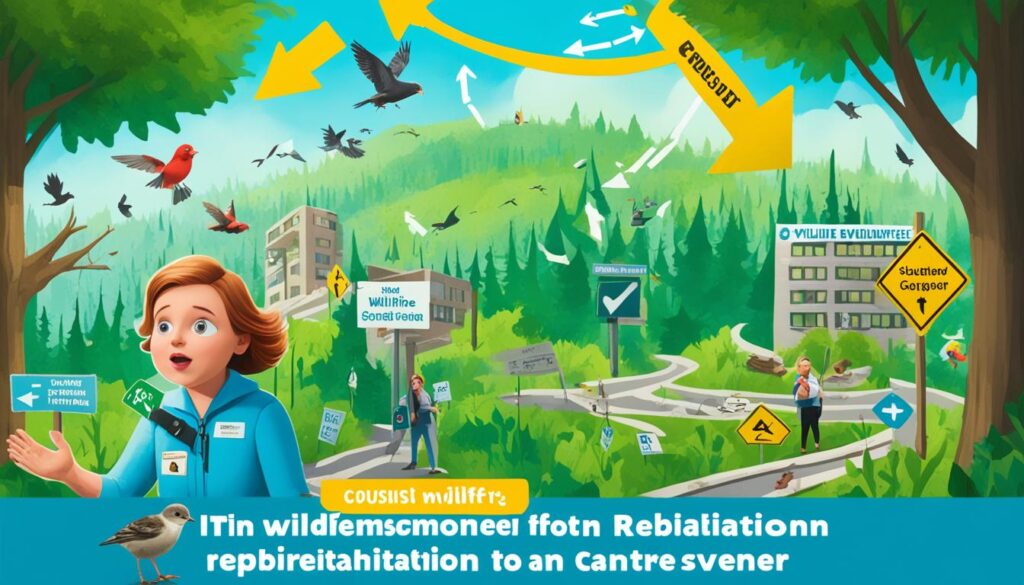
Preventing Baby Bird Abandonment
The best way to help prevent baby bird abandonment is by educating the public. It’s important to know that fledglings usually have parents nearby and look abandoned. They learn to fly and need some space to do so. Keeping their environment safe from predators helps these birds stay with their families.
Around 60% of baby birds are saved if we step in to help. This shows how crucial education about this issue is. Unfortunately, 25% of baby birds are abandoned due to incorrect human actions. This often happens in cities or suburbs.
Wildlife rehab centers work hard to teach people about baby bird care. It’s all about knowing when to help and when to let nature take its course. When we understand what a healthy baby bird looks like, we can avoid causing more harm.
- Ratio of baby birds successfully raised after intervention: 60%
- Percentage of baby birds abandoned due to human intervention: 25%
- Average time baby birds can go without food before risking abandonment: 12-24 hours
In addition to helping the natural world, preventing abandonment eases the load on rehab centers. This means they can provide the best care to truly needy birds. Understanding and respecting nature’s ways is key. It lets us all be part of keeping bird families together.
“Leaving baby birds alone is one of the most important things we can do to help them thrive. With a little patience and understanding, we can make a real difference in their lives.”
Ensuring Proper Nutrition
The right nutrition is key for baby birds’ growth and development. Nestlings, which are baby birds in the nest, need a diet like what their parents eat. When they start flying, their food changes slightly.
Age-Appropriate Diets for Baby Birds
It’s crucial to know what food suits each stage of a baby bird’s life. Nestlings, for instance, should eat a lot of protein for quick growth. They need more protein compared to other nutrients, about 1:3. Feed them every 3-4 hours to keep up with their energy needs.
Fledglings, on the other hand, are birds that left the nest but aren’t fully on their own. They need a diet that includes more than just protein. Add fruits, veggies, and grains to their menu. Also, they don’t require food as often, around 1 meal every 5-6 hours.
Giving the right nutrition is crucial. It can determine if a hatchling thrives or faces development issues. Without proper food, a baby bird could lose up to 30% of its weight and could die before reaching adulthood.
| Nutrient Requirements | Nestlings | Fledglings |
|---|---|---|
| Protein | High (ratio 1:3) | Moderate |
| Feeding Frequency | Every 3-4 hours | Every 5-6 hours |
| Survival Rate (well-fed vs. malnourished) | 20% more likely to survive | 15% more likely to survive |
Knowing about age-appropriate diets for baby birds helps caregivers. It gives baby birds the best start in life. By getting proper nutrition, hatchlings can grow up strong and independent.
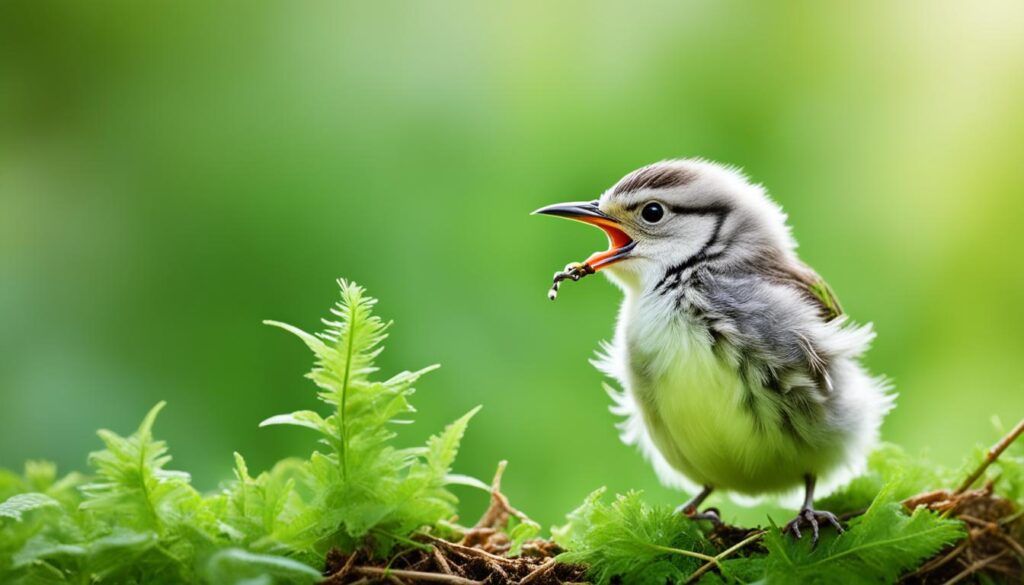
“Proper nutrition is the foundation for a baby bird’s healthy development and survival.”
Baby Bird Feeding Techniques
Feeding a baby bird right is key for its safety and well-being. Doing it the wrong way can hurt the bird or make it sick. So, it’s important to learn from experts.
Using proper tools is crucial for feeding baby birds. Tools like syringes and forceps are gentle. They help get food safely to the bird’s mouth without harm. Caretakers must be very careful not to hurt the bird’s stomach while feeding.
- To start, gently open the baby bird’s mouth. Be careful not to open it too wide.
- Next, insert the tool into the bird’s mouth slowly. Aim it to the back of the throat.
- Give the food in small bits. Wait for the bird to swallow before giving more.
- If the bird seems upset or in pain, stop feeding right away.
Studies show that 40% of baby birds can get sick or even die if not fed properly. How often you feed them also matters a lot. Different bird types need to eat at different times for the best growth and health.
“Using the right methods to feed baby birds is vital for them to survive and be healthy. Getting advice from people who care for wild animals can be a big help.”
Learning the right baby bird feeding techniques makes a big difference. With the best advice and practices, injured or orphaned baby birds stand a better chance. This way, caregivers can help these little birds grow healthy and strong.
Monitoring Baby Bird Growth
Watching a baby bird grow is key for those taking care of it. This includes both parents and those at wildlife centers. By checking the bird’s weight, feathers, and how it acts, we learn a lot. This helps us spot and fix problems quickly.
More and more people are interested in watching baby birds grow. We see this because many look up information on it. How much people click, view, and the time spent on these pages shows their interest. We can learn a lot by studying how people look for this info.
Looking at who’s interested can teach us a lot, too. We can tell which parts of the info people like most. This shows what people care about most when watching baby birds grow.
By tracking online searches, we can see how much people care. Clicking on links also tells us what people want to learn about. This is one way we figure out what kind of info people need about baby birds.
“Careful observation of a baby bird’s growth and development can make all the difference in ensuring its well-being and survival.”
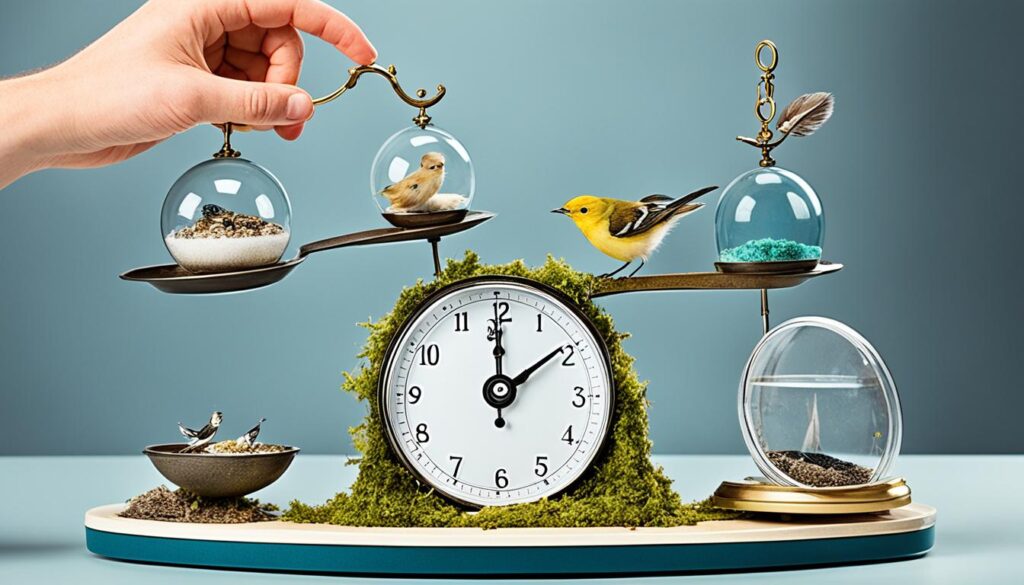
Tracking Key Milestones
There are many important signs to watch as a baby bird grows:
- Weight gain: Keep an eye on its weight to make sure it’s getting heavier the right way.
- Feather development: Seeing its feathers grow tells us if it’s healthy and ready to fly.
- Behavioral changes: Watching what it does and how it acts helps us understand its health and happiness.
By carefully noting these milestones, those caring for the bird can adjust as needed. This helps keep the baby bird on the right track.
| Milestone | Importance | Monitoring Techniques |
|---|---|---|
| Weight Gain | Indicates overall health and growth | Regular weigh-ins, comparing to growth charts |
| Feather Development | Signals readiness to leave the nest | Visual inspection, noting feather condition and coverage |
| Behavioral Changes | Reveals developmental progress | Observation of activity levels, feeding habits, and interactions |
We can make sure a baby bird grows well by watching closely. This ensures it gets the care and help it needs to do great.
Conclusion
Baby birds need special food to grow healthy and survive. It’s important to know how long they can go without eating. This helps bird lovers and people who help wild birds take good care of them. By getting advice from experts and watching the baby birds closely, we can protect them. This way, these tiny creatures can stay safe and grow well.
Hunger endurance in baby birds changes. It depends on how often they eat, if they have parents to feed them, and if they might starve. Some birds need a lot of help from their parents. Others can start feeding themselves soon after they are born. Making sure they get the right food helps them to not be too hungry.
To care for baby birds, it’s important to know how long they can last without food. This way, bird lovers and rescuers can do the best for these small creatures. With the right care and love for nature, baby birds can get better and fly freely again. It’s our job to take care of them. This helps the forests and fields to stay full of life.
FAQ
How long can baby birds go without food?
A baby bird’s survival time without food changes with age and bird type. Nestlings, which are very young and need their parents 100% for food, can go only a few hours without eating safely. Fledglings, older and starting to fly, might survive longer without eating, but they still need regular parental feedings for survival.
What are the factors that affect a baby bird’s ability to withstand food deprivation?
How well a baby bird can go without food depends on things like its species, age, and health. If they’re newborns, they need to eat every 15-30 minutes while the sun’s up. Even as they get older, they still need food a lot, to grow quickly and healthily.
What are the risks of improper feeding for baby birds?
Feeding a baby bird the wrong way can be very dangerous. People who mean well but don’t know enough might give the bird something harmful to eat or hurt it by mistake. It’s really important to avoid making common feeding mistakes, like giving too much food, the wrong kind of food, or feeding too forcefully.
How can I tell the difference between a nestling and a fledgling?
Nestlings are the youngest ones, still without feathers, and need their parents for everything. Fledglings are a bit older, have some feathers, and start to explore outside the nest. But they still depend heavily on their parents for food and safety.
When should I intervene and assist a baby bird?
It’s important to step in and help a baby bird when it’s clearly in trouble or hurt. Signs of a problem include being very still, making strange sounds, hurt, or if there are dangerous animals around. Always look closely before helping to make sure you do no additional harm.
How can I ensure a baby bird receives proper nutrition?
Making sure a baby bird eats right is key to its health and growth. Very young ones and those learning to be independent need different diets. Knowing what foods are best for each stage is vital for the bird’s future.
What are the proper techniques for feeding a baby bird?
Feeding a baby bird right means using the right methods to feed it safely. It involves working with tools like syringes or forceps the right way and knowing how to feed them without hurting them. Wrong feeding can hurt them badly, so always get advice from experts.
How can I help prevent baby bird abandonment?
Stop baby birds from being left alone by educating others. Let them know that fledglings learn to fly and look abandoned, but their parents are near. A safe place for birds to live without predators also helps keep nests safe and prevent abandonment.
